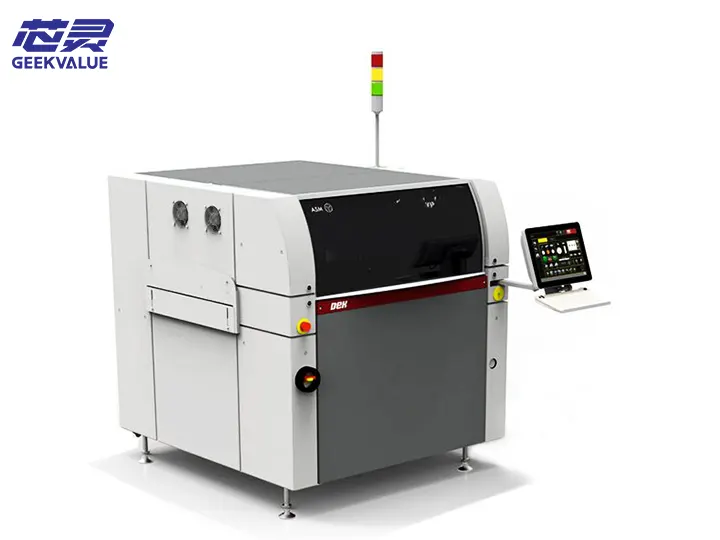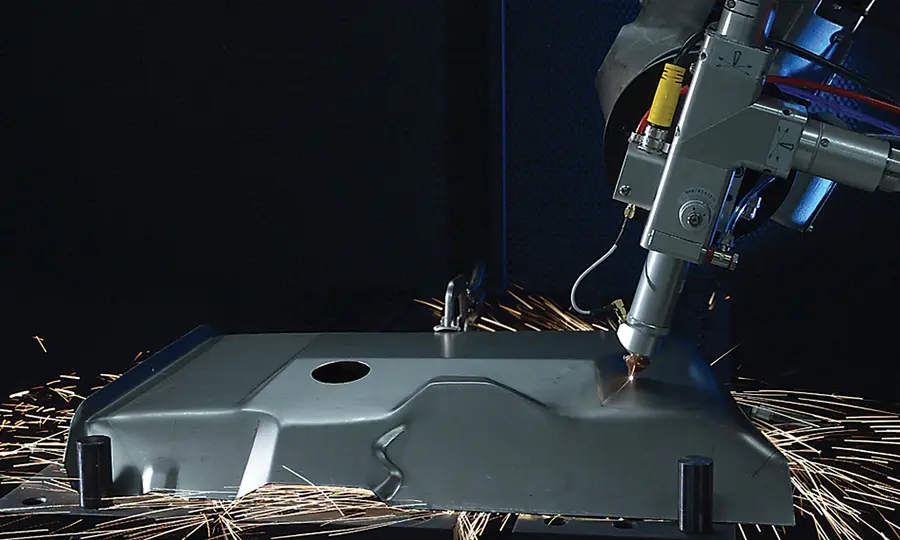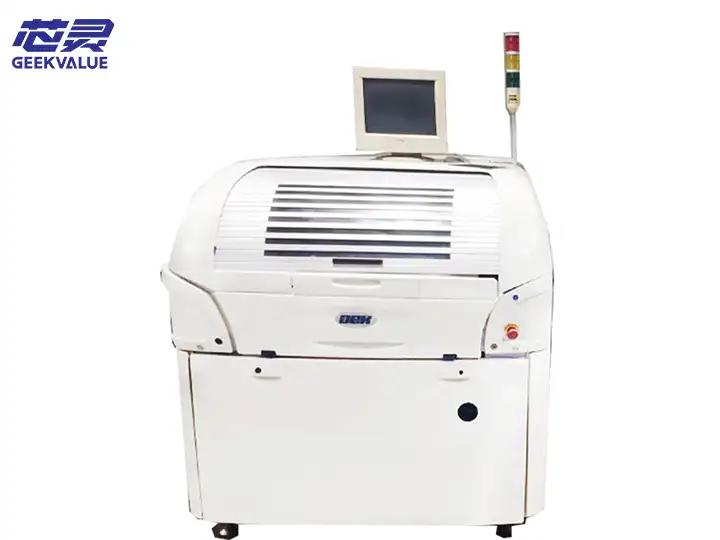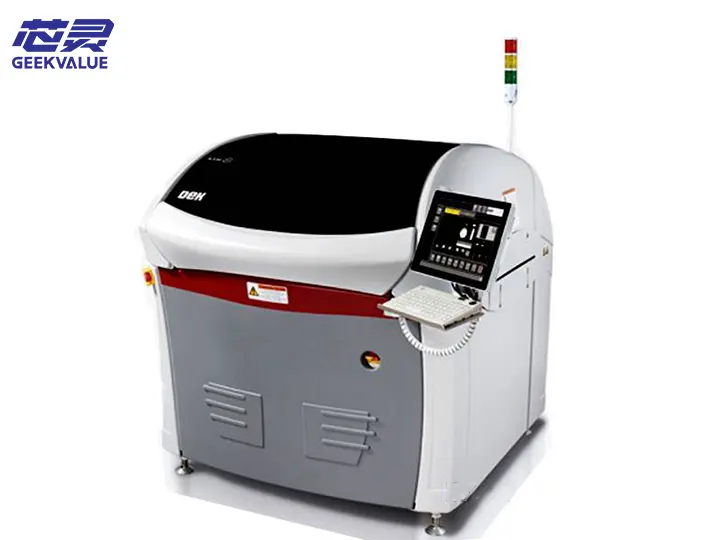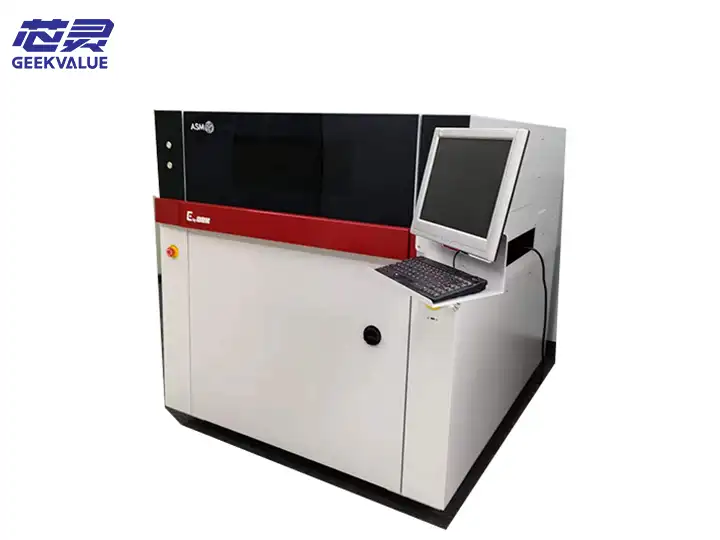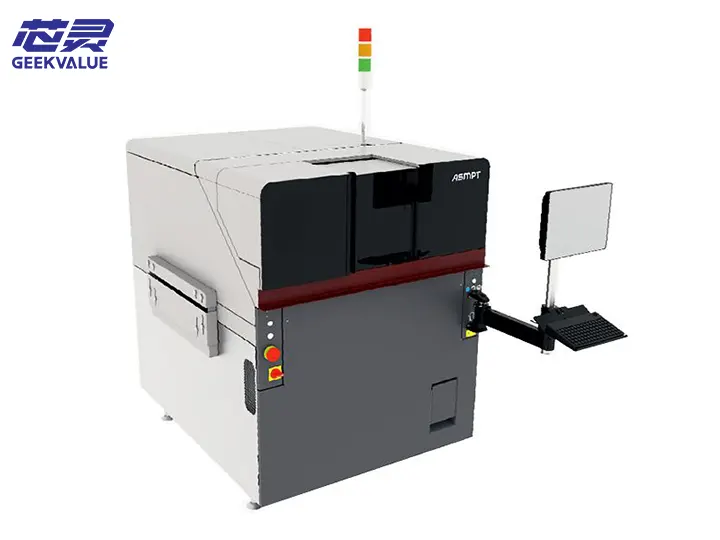DEK 03I is a benchmark product for entry-level fully automatic printing presses, designed for small and medium batches and high-variety electronic assembly. With stable printing performance and excellent cost performance, it is widely used in consumer electronics, automotive electronics, LED lighting and other fields, especially suitable for:
Small and medium-sized SMT production lines
R&D proofing center
Multi-variety fast switching scenarios
II. Core specifications and technical parameters
Technical indicators DEK 03I detailed parameters
Maximum printing area 584mm×584mm
Printing accuracy ±25μm @3σ
Printing speed 100-400mm/s (adjustable)
Steel mesh thickness adaptation 0.1-0.3mm
Substrate thickness range 0.4-6.0mm
Alignment system 2MP CCD vision (including laser positioning)
Scraper system Dual scrapers automatic switching (maximum pressure 15kg)
Power supply requirements Three-phase AC 380V/2.5kVA
III. Core working principle
1. Printing process
PCB positioning: vacuum adsorption + edge clamp fixation (positioning accuracy ±0.01mm)
Visual alignment: CCD recognition MARK point (FOV 20mm×20mm)
Solder paste filling: scraper pushes solder paste at an angle of 30-60°
Demolding control: intelligently adjust separation speed (0.1-3mm/s)
2. Key subsystems
Motion control: servo motor + precision lead screw (repeat positioning accuracy ±5μm)
Pressure management: closed-loop control of scraper pressure (adjustable 50-500g/cm²)
Temperature and humidity compensation: real-time monitoring of environmental parameters and automatic adjustment
Fourth, five core advantages
High cost performance
Purchase cost is 20% lower than similar models
Energy consumption <2.5kW/h (energy-saving mode can reduce 30%)
Excellent stability
Key components (lead screw, guide rail) use THK/NSK brand
MTBF>10,000 hours
Intelligent operation
Graphical touch screen (supports Chinese and English interface)
Formula memory function (can store 100+ programs)
Flexible adaptation
Model conversion is completed in 15 minutes
Supports various types of solder paste such as no-clean/water-washable
Precision printing
Minimum printable 0402 pad
Solder paste thickness deviation <±10%
V. Typical application scenarios
Smartphone: 0.4mm pitch BGA printing
Automotive electronics: large-size LED driver board
Industrial control: thick copper plate (6mm) printing
Medical equipment: micro sensor board printing
VI. Full life cycle maintenance plan
1. Daily maintenance specifications
Maintenance items Cycle Operation standard
Scraper cleaning Every shift Use dust-free cloth + IPA cleaning
Steel mesh tension detection Weekly Tension meter measurement (≥35N/cm²)
Guide rail lubrication Monthly Apply SKF LGHP2 grease
Vacuum generator inspection Quarterly Vacuum test (≥-80kPa)
2. Key spare parts list
Scraper blade (DEK original recommended, life of about 500,000 times)
Vacuum nozzle (standard/large size)
CCD camera protection lens
Servo motor encoder
3. Calibration cycle table
Calibration items Cycle Tool
Visual alignment accuracy 1 month Standard calibration plate (including 0.1mm lines)
Scraper parallelism 3 months Laser interferometer
Platform level 6 months Electronic level (0.01° accuracy)
VII. In-depth fault diagnosis guide
1. Fault tree analysis (taking printing offset as an example)
Possible causes:
Visual alignment abnormality (45%)
PCB positioning looseness (30%)
Insufficient steel mesh tension (15%)
Others (10%)
Diagnostic process:
Check MARK point recognition rate (should be ≥99.5%)
Test vacuum adsorption force (standard ≥-65kPa)
Measure steel mesh tension (center point ≥30N/cm²)
2. Five common fault handling
Fault 1: E205 alarm (visual alignment failure)
Handling steps:
Clean CCD lens (use special cleaning rod)
Adjust light source intensity (recommended 70-80%)
Update MARK point parameters (expand search range by 10%)
Fault 2: Solder paste pull tip
Root cause:
Excessive demoulding speed (accounting for 60%)
Abnormal solder paste viscosity (accounting for 30%)
Solution:
Parameter adjustment
1. Reduce demoulding speed to 0.5mm/s
2. Increase scraper pressure (recommended +10%)
3. Check solder paste reheating time (need ≥4h)
Fault 3: Abnormal scraper pressure
Quick troubleshooting:
Check pressure sensor wiring
Calibrate pressure zero point (need to be performed in unloaded state)
Test servo motor current (standard 1.5A±0.2)
Fault 4: Vacuum leakage
Preventive measures:
Check nozzle seal weekly
Replace vacuum filter monthly
Fault 5: System freeze
Emergency treatment:
Backup current program
Run memory test after restart (command: *#MEMTEST)
Update system firmware (need to contact after-sales)
VIII. Technology upgrade path
1. Hardware upgrade options
Visual upgrade package: 2MP→5MP camera (accuracy increased to ±15μm)
Intelligent scraper system: Add real-time pressure feedback function
2. Software upgrade route
Basic version→Advanced version:
Add 3D solder paste detection function
Support SPC data analysis
3. Production line integration solution
Linked configuration:
DEK 03I + SIPLACE SX2 → form a compact production line
(UPH can reach 45,000 points)
IX. Procurement decision support
1. Cost-benefit analysis
Project DEK 03I Competitive product A Advantage comparison
Single printing cost ¥0.15 ¥0.22 32% lower
Line change time 8min 15min 47% faster
Printing yield 99.2% 98.5% 0.7% higher
2. Selection suggestions
Standard version: suitable for users with limited budget (about ¥350,000)
High-end version: recommended for automotive electronics customers (about ¥480,000)
X. Summary and outlook
DEK 03I maintains its leading position in the entry-level market through modular design and intelligent pressure control. Its ±25μm printing accuracy and 400mm/s high-speed printing perfectly balance efficiency and quality. With the launch of DEK's new generation Photon platform, 03I users can seamlessly upgrade to intelligent printing solutions.


